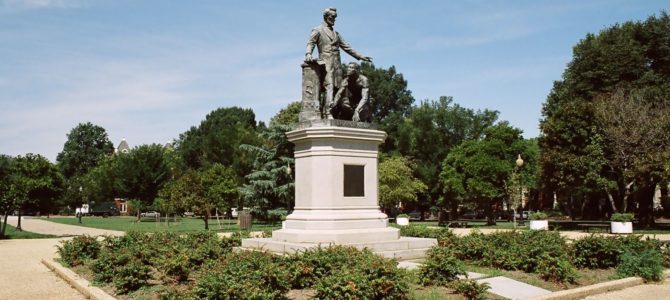In Lincoln Park, Washington DC stands a statue called Emancipation Memorial, showing Abraham Lincoln and a freed slave. If activists on the left would have their way, the statue would no longer stand.
The statue was erected in 1876, from funding exclusively donated by freed slaves, primarily African-American veterans of Civil War. Sculptor Thomas Ball designed and created the monument, which shows Lincoln standing above a kneeling man fashioned after freed slave and Union informant Archer Alexander.
It was unveiled in April 14, 1876, in memorial of the 11th anniversary of Lincoln’s assassination. Frederick Douglass gave the keynote address to a crowd of more than 25,000 people, including President Ulysses S. Grant.
As many controversial historical statues have been slated for removal in the recent weeks, activists have called for Emancipation Memorial to fall. They argue that the statue is racist, depicting Lincoln standing above the nameless, kneeling African-American figure. Lincoln being fully clothed compared to the African-American man’s half-nakedness likewise frustrates and bothers those offended by the statue.
Further, the physical position, with Lincoln’s hand outstretched over the other man, is said to imply Lincoln giving freedom to the former slaves; some worry that this imagery erases the sacrifice and risks taken by the slaves who escaped and worked to free others.
This criticism of the statue is not new; these questions have been swirling since the statue’s debut. Historian and Douglass scholar Dr. Erik Chaput said on the subject, “I think it did shock people in the 1870s, how it showed a dismissive quality of slaves hobbling at Lincoln’s feet. It didn’t show the glory of slaves who had fought for their freedom, escaped like Frederick Douglass had and risked everything. That anger was there at the time. But Douglass looks past that.”
Many still support the statue remaining, as it represents a flawed but constantly improving United States. Douglass said as much in his dedication speech. This speech is a masterclass of oratory and should be widely read alongside his famous Fourth of July address. Douglass beautifully expresses the need to honor Lincoln and his contributions while acknowledging the former president’s failings.
“For those who are trying to take it down, I would point them to Douglass’s speech,” Chaput said. “Douglass pulls no punches about Lincoln. He’s very critical at times, yet he manages to talk about his relationship to Lincoln and what believed Lincoln did, which was transformative, and he acknowledges that. He’s able to be that ferocious Douglas as a critic, but he’s also able to convey, as do so many of his speeches, this profound sense of hope in the American experiment.”
For the upcoming future, the stature will remain standing. Katie Liming of the National Park Service said:
Rather than remove the statue from Lincoln Park, it should spark increased discussion about both the flaws and triumphs of Lincoln. The former president was a complex figure, and seeing him through the eyes of Douglass allows us in the 21st century to look back with honesty and a broader, nuanced view.
“It would be a horrible tragedy if that statue were to come down,” Chaput said. “If people can read and understand about Frederick Douglass and his viewpoint, I think those that want to remove the statue may come to a different sense about it.”
Rather than erase the difficult or complex chapters of American history, we must follow in the example of Chaput and the NPS, and face the complicated truth of our history. By smoothing over the rough edges, or exclusively focusing on the shortcomings, we do ourselves a great disservice.
There is no better defense for the importance of the monument than Douglass’s closing words in its dedication.
Fellow-citizens, I end, as I began, with congratulations. We have done a good work for our race today. In doing honor to the memory of our friend and liberator, we have been doing highest honors to ourselves and those who come after us; we have been fastening ourselves to a name and fame imperishable and immortal; we have also been defending ourselves from a blighting scandal.
When now it shall be said that the colored man is soulless, that he has no appreciation of benefits or benefactors; when the foul reproach of ingratitude is hurled at us, and it is attempted to scourge us beyond the range of human brotherhood, we may calmly point to the monument we have this day erected to the memory of Abraham Lincoln.









